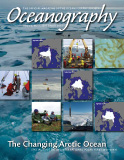Article Abstract
Over the last 60 years, the perception of the Arctic Ocean has changed from a hostile, sluggish, steady, ice-covered environment with little global impact to an ocean that has become increasingly accessible, apparently rapidly changing, only partly ice-covered, and connected to the global meridional overturning circulation. Our new observations demonstrate that waters off Northwest Greenland constitute the final limb in the grand cyclonic circulation of the Atlantic layer in the Arctic Ocean. These waters with an Atlantic water mass signature are warming in Nares Strait to the west of Greenland as they are elsewhere. Estimates of the magnitude and uncertainty of this warming are emerging from both moored observations and historical hydrographic station data.
Ocean temperatures sensed by instruments moored 3 m above the bottom between 228 and 366 m depth in Nares Strait suggest a mean warming of about 0.023 ± 0.015°C per year for the 2003–2009 period at 95% confidence. Salinity changes for the same period are not significantly different from zero. Nevertheless, oscillating bottom temperatures covary with salinities. Mean bottom salinities in Nares Strait exceed 34.56 psu while no water with salinities above 34.51 psu occurs in Baffin Bay to the south. These data indicate a dominantly northern source for the waters sensed by our moorings. Mean bottom temperatures hover near 0°C, which suggests minimal influence of waters from the northeastern Amundsen Basin in the Arctic Ocean. Thus, we conclude that the observed warming originates from the northeastern Canadian Basin to the southwest of our study area.
In addition to these mean conditions, we find large interannual variability. For example, significant freshening emerges for the 2003–2006 period that reaches –0.02 ± 0.008 psu per year without significant concurrent temperature trends at three sensor locations. These data contrast with the 2007–2009 observational period when five different sensors all indicate warmer waters (0.063 ± 0.017°C per year) and saltier waters (0.027 ± 0.01 psu per year), which reverses the 2003–2006 freshening. We speculate that some of these observed changes are caused by a changing ice regime. During the 2003–2006 winters, ice was landfast, while during 2007–2009 it was generally mobile year-round. The warming impacts tidewater glaciers along northern Greenland with sill depths below 300 m, for example, Petermann Gletscher.

